|
by
David Woods
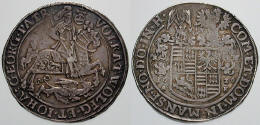
© 2002, Classical
Numismatic Group, Inc. A silver 2 thaler piece (57.48gm) issued in
Mansfeld, Germany, by Volrat VI, Wolfgang III von Borstädt,and Johann
Georg II von Eisleben. 1626. The obverse depicts St. George riding on
horseback, spearing a dragon. The obverse legend reads: VOLRAT. WOLFG. ET.
IOHA: GEORG. PATR. The obverse depicts a coat of arms. The obverse legend
reads: COM. ET. DOM. IN. MANSF. NO. DO. IN. H., helmeted arms. Tornau
735a; Davenport 6961. Toned, good VF. Rare, valued c.US $6000)
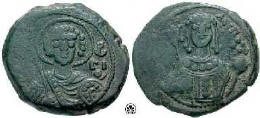
© 2001, Classical
Numismatic Group, Inc. A tetarteron issued at Thessalonica by the
Byzantine emperor Manuel I (1143-80). The obverse depicts the emperor
holding a labarum and globus cruciger, while the reverse depicts a facing
bust of St. George. DOC IV 6; Hendy pl.17, 13; SB 1975. Nice VF, valued
c.US $60.
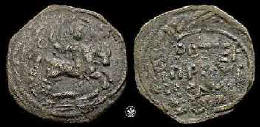
© 2000, Classical
Numismatic Group, Inc. A bronze follis (3.44 gm) issued by Roger of
Salerno, Regent of Antioch (1112-1119). The reverse depicts St. George,
nimbate, on horseback right, spearing the dragon; O-CP in outer field .
The obverse bears legend ROGIER PRIGKP OCANT [IOK] in four lines within
beaded circle. Overstruck on previous type. Schlumberger II/12; Metcalf LE
95-101; CCS 9. VF, valued c.US $200.
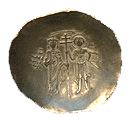 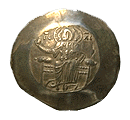
© 1999, Athina S.A.
An electrum trachy issued at Constantinople by the Byzantine emperor John
II Comnenus (1118-1143). The reverse depicts the emperor and St. George
standing on either side of patriarchal cross, while the obverse depicts
Christ seated on a throne. EF, valued at Swiss Francs 480
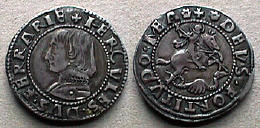
© 1999, Classical
Numismatic Group, Inc. A silver grossone (3.77gm) issued at Ferrara,
Italy, under Duke Hercules I d'Este (1471-1505), c.1475. The obverse
depicts a bust of the duke facing left. The legend reads: HERCVLES DVX
FERRARIE, "Hercules, Duke of Ferrara". The reverse depicts St. George
slaying a dragon with the legend DEVS FORTITVDO MEA, "God (Is) My
Strength". See CNI X pg.437, 33 variety; Biaggi 771 variety. VF, valued at
US $1,250.
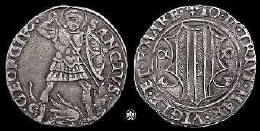
© 2000, Classical
Numismatic Group, Inc. A silver grosso (3.26 gm) issued at Mesocco,
Switzerland, under Gian Giacomo (Grafen von) Trivulzio (1487-1518). The
reverse depicts St. George, standing, and spearing a dragon on the ground.
The legend reads: SANCTUS GEORGIUS, "St. George". The obverse legend
reads: IO. IA. TRIVI. MAR. VIGLE. ET. E. MARE. GVF, valued at US $300.
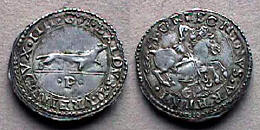
© 1999, Classical
Numismatic Group, Inc. A silver armellino (1.13gm) issued at Urbino,
Italy, under Duke Guibaldus II (1538-74). The obverse depicts a weasel
facing right. The legend reads: GUIBALDUS II URBINI DUX IIII, "Guibaldus
II, Fourth Duke of Urbino". See CNI XIII, pg. 537, 147. VF, valued at US
$365.
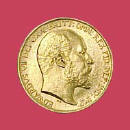 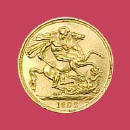
© 1999, Harlan J.
Berk Ltd. A gold 2 pound coin issued in Great Britain under King Edward
VII in 1902. The obverse depicts a bust of the king facing right. Its
legend reads EDWARDUS VII DEI GRA BRITT OMN REX FIDE DEF IND IMP, "Edward
7th, by the grace of God, King of the Whole of Britain, Defender of the
Faith, and Emperor of India." The reverse features Benedetto Pistrucci's
famous depiction of St. George slaying the dragon which has continued to
appear on British gold coinage since its first use in 1817. AU, valued at
US $550.
Return to Table of Contents
|